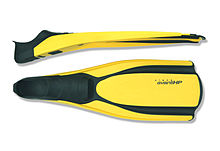အသုံးပြုသူ:Runab WMF/Burmese test page


Swimfins, swim fins, fins or flippers are finlike accessories worn on the foot or leg and made from rubber, plastic or combinations of these materials, to aid movement through the water in water sports activities such as swimming, bodyboarding, bodysurfing, kneeboarding, riverboarding, underwater hockey, underwater rugby and various other types of underwater diving.
Swimfins help the wearer to move through water more efficiently, as human feet are too small and inappropriately shaped to provide much thrust, especially when the wearer is carrying equipment that increases hydrodynamic drag.[၁][၂][၃] Very long fins and monofins used by freedivers as a means of underwater propulsion do not require high frequency leg movement. This improves efficiency and helps to minimize oxygen consumption. Short, stiff-bladed fins are effective for short bursts of acceleration and maneuvering, and are useful for bodysurfing.
History
ပြင်ဆင်ရန်Early inventors, including Leonardo da Vinci and Giovanni Alfonso Borelli, toyed with the concept of swimfins.[၄]
Benjamin Franklin made a pair of early swimfins when he was a young boy living in Boston, Massachusetts near the Charles River; they were two thin pieces of wood, about the shape of an art palette, which allowed him to move faster than he usually did in the water.[၅]
Modern swimfins are an invention from the Frenchman Louis de Corlieu, capitaine de corvette (Lieutenant Commander) in the French Navy. In 1914 De Corlieu made a practical demonstration of his first prototype for a group of navy officers, Yves le Prieur among them[၆] who, years later in 1926, invented an early model of scuba set. De Corlieu left the French Navy in 1924 to fully devote himself to his invention.[၇] In April 1933 he registered a patent (number 767013, which in addition to two fins for the feet included two spoon-shaped fins for the hands) and called this equipment propulseurs de natation et de sauvetage (which can be translated literally as "swimming and rescue propulsion device").[၆]
After floundering for years, even producing his fins in his own flat in Paris, De Corlieu finally started mass production of his invention in France in 1939. The same year he issued a licence to Owen Churchill for mass production in the United States. To sell his fins in the USA Owen Churchill changed the French De Corlieu's name (propulseurs) to "swimfins", which is still the common English name. Churchill presented his fins to the US Navy, which decided to acquire them for its Underwater Demolition Team (UDT). American UDT and British COPP frogmen (COPP: Combined Operations Pilotage Parties) used the "Churchill fins" during all prior underwater deminings, thus enabling in 1944 the Normandy landings. During the years after World War II had ended, De Corlieu spent time and efforts struggling in civil procedures, suing others for patent infringement.[၈]
In Britain, Dunlop made frogman's fins for World War II, but after the war saw no market for them in peacetime, and, after the first supply of war-surplus frogman's kit was used up, the British public had no access to swimfins (except for home-made attempts such as gluing marine plywood to plimsolls), until Oscar Gugen began importing swimfins and swimming goggles from France.[၄]
In 1946 Lillywhites imported about 1,100 pairs of swimfins; they all sold in under 3 months.[၉]
In 1948 Luigi Ferraro, collaborating with the Italian diving equipment company Cressi-sub, designed the first full-foot fin, the Rondine, named after the Italian word for swallow. A distinctive feature of Cressi's continuing Rondine full-foot fin line is the embossed outline of the bird on the foot pockets and the blades.
In 1949 Ivor Howitt or a friend of his mailed to the Dunlop Rubber Company for swimfins; Dunlop answered that they had no plans to make swimfins and saw no use for them in peacetime. Howitt made his own swimfins with innertube rubber stretched across a frame of stiff rubber tube.
Types
ပြင်ဆင်ရန်References
ပြင်ဆင်ရန်- ↑ "Evaluation of fins used in underwater swimming" (2003). Undersea Hyperbaric Medicine 30 (1): 57–73. Undersea and Hyperbaric Medical Society. PMID 12841609. Retrieved on 11 February 2010.
- ↑ Pendergast D, Mollendorf J, Zamparo P, Termin A, Bushnell D, Paschke D (2005). "The influence of drag on human locomotion in water". Undersea Hyperb Med 32 (1): 45–57. PMID 15796314. Retrieved on 2008-08-25.
- ↑ Pendergast DR, Tedesco M, Nawrocki DM, Fisher NM (May 1996). "Energetics of underwater swimming with SCUBA". Med Sci Sports Exerc 28 (5): 573–80. doi:. PMID 9148086. Retrieved on 2008-08-25.
- ↑ ၄.၀ ၄.၁ Davis, RH (1955)။ Deep Diving and Submarine Operations (6th ed.)။ Tolworth, Surbiton, Surrey: Siebe Gorman & Company Ltd။
- ↑ Benjamin Franklin (USA) 1968 Honor Contributor။ International Swimming Hall of Fame။ 2009-05-29 တွင် ပြန်စစ်ပြီး။
- ↑ ၆.၀ ၆.၁ Alain Perrier, 250 réponses aux questions du plongeur curieux, Éditions du Gerfaut, Paris, 2008, ISBN 978-2-35191-033-7 (p.65, in French)
- ↑ In the 1950s capitaine de frégate (Commander) Philippe Tailliez still was thinking that De Corlieu conceived his fins for the first time in 1924 (in fact he'd started ten years earlier).
- ↑ Alain Perrier, 250 réponses aux questions du plongeur curieux, Éditions du Gerfaut, Paris, 2008, ISBN 978-2-35191-033-7 (p.66, in French)
- ↑ Historical Diving Society Magazine, issue 47 (summer 2009), pages 12 etseq, ISSN 1368-0390